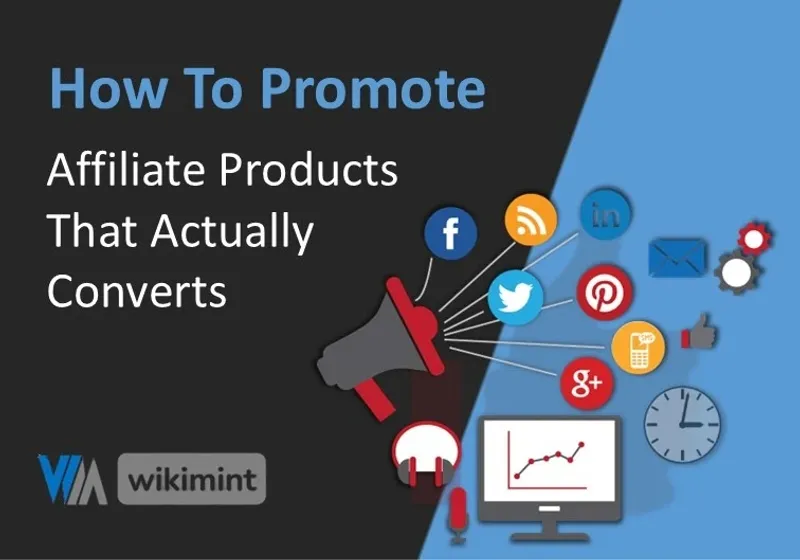If you’ve been stuck in the cycle of promoting products but not seeing results, you’re not alone. Most beginners jump straight into “selling” without understanding the real art behind preselling - a powerful method that turns curious visitors into confident buyers.

Discover proven methods to market affiliate products through blogs, niche websites, SEO, and social platforms to grow your audience and maximize earnings.
In this article, I’ll walk you through how to promote affiliate products the right way, using storytelling, trust-building, and strategic tools. Whether you’re a beginner or looking to scale your results, this guide is packed with practical steps and examples that work.
Summary: The Secret Sauce of Successful Affiliate Marketing
Affiliate marketing is not just about dropping a link and hoping someone buys. It’s about warming up your audience - preselling - so that by the time they hit the product page, they’re already half convinced. Affiliate marketing is one of the most talked-about online businesses.
This guide covers:
- Why direct linking often fails
- What preselling really means
- How to build a Trustworthy Pre-Sell Page: A Step-by-Step Guide
- Leveraging affiliate products to build your email list
- Follow-up strategies that drive conversions
Ready? Let’s break it down.
Introduction: The Mistake Most Affiliates Make
When people start promoting affiliate products, their first instinct is to copy and paste their affiliate link everywhere - Facebook, Reddit, maybe even a few forums. And yes, sometimes they do make a few sales this way. But the success is usually inconsistent. In addition to just copy-pasting links, affiliate marketing involves a combination of digital marketing strategies.
Why? Because it skips the most important part of the sales journey: building trust.
Ask yourself this - would you spend $97 on a course from someone you don’t know who just posted a random link in the comments? Unlikely.
The real pros in affiliate marketing know that selling comes second. First, you build confidence. That’s where preselling comes in.
What Is Preselling? And Why It Works
Preselling is the process of preparing your audience emotionally and logically before you pitch them a product. Instead of sounding like a salesman, you sound like a helpful friend who’s sharing what worked for them.
Let’s compare the two:
Selling sounds like this:
“Boost your sales by 300%! Click now to unlock the secret.”
Preselling sounds like this:
“I tried this simple tool last month and saw a 300% increase in my sales. I didn’t expect that kind of result. Here’s how I did it…”
See the difference?
Preselling is subtle but powerful. It shifts your tone from pushy to personal. And people are far more likely to trust someone who’s “been there” than someone who’s just trying to make a sale.
How to Write a High-Converting Presell Page
Let’s break down what goes into a successful presell page - the kind that not only grabs attention but also builds confidence and converts.
Start With a Hook
Your first sentence needs to spark curiosity or show proof. For example:
“Last week, I made $180 in commissions using a method I hadn’t tried before. I wasn’t even expecting it to work…”
This kind of opening pulls the reader in. They’re thinking: What did you do? Can I do it too?
Share a Relatable Story
Be real. You don’t need massive success - just something that others can relate to.
Here’s an example:
“I used to spend hours trying to find the right product. Then I discovered this software that shows the top converting offers - and it made my first $100 in a week.”
You’re not bragging. You’re sharing a journey.
Provide Social Proof (Even If It’s Not Yours)
If you’re new and don’t have results to show yet, that’s okay. You can leverage proof from others.
Let’s say the product you’re promoting has testimonials. Use them (with permission). Write about how others are getting results:
“John, a beginner affiliate like me, made $500 in his second week using this strategy. That boost of confidence encouraged me to give it a try.”
Now you’re showing that the method works - and it’s not just about you.
Don’t Just Sell - Build a List
Now, here’s where things get really interesting…
Most affiliates send traffic straight to a sales page. That’s it. No follow-up, no second chance. If the visitor doesn’t buy right away, it’s game over.
Smart affiliates build a list.
Why?
Because when someone gives you their email, you get a second chance. And a third. You have the opportunity to build a connection, provide value, and ultimately gain their trust—and their business.
The Email Funnel Strategy
Let’s look at a simple affiliate email funnel:
Squeeze Page (Opt-In):
You offer something valuable - like a free ebook, checklist, or even just a strategy - in exchange for their email.
Redirect to Sales Page:
After opting in, they’re sent to the affiliate product page.
Email Follow-Ups:
Over the next few days, you send helpful tips, results, stories, and then eventually reintroduce the affiliate product with your link.
Real-World Example:
Suppose you’re promoting an online course about building Shopify stores. You could create a simple landing page:
“Want to see how beginners are earning $1,000/month with simple Shopify stores? Enter your email and I’ll walk you through the same method.”
After they sign up, send them to the course’s sales page. Then over the next week, you email:
- “Why Shopify still works in 2025”
- “The 3 mistakes I made setting up my first store”
- “What I’d do differently if I started again”
- “Here’s that course I mentioned - still the best I’ve seen”
This is how preselling and email marketing go hand-in-hand.
Actionable Tips to Promote Affiliate Products Effectively
If you want to get real traction, here are practical steps to follow:
Build a Trust-Driven Funnel
- Step 1: Choose a product you believe in. Test it if possible.
- Step 2: Create a presell landing page (even a one-pager works).
- Step 3: Capture email leads with a value-packed hook.
- Step 4: Send helpful follow-ups that warm your audience.
- Step 5: Insert your affiliate link naturally into your emails or content.
Use Personal Language
Use words like “I,” “my,” and “you.” Write as if you’re talking to a friend over coffee, not giving a lecture.
Stay Honest
Don’t fake income screenshots or testimonials. Be transparent. Authenticity sells better than hype.
Bonus Tip: Use Other People’s Success (With Permission)
Let’s say you haven’t made any sales yet. That’s okay.
You can still:
- Interview someone who has used the product successfully.
- Use testimonials from the sales page (again, with permission).
- Share screenshots or earnings proofs provided by the vendor.
This is called social leverage, and it’s totally ethical if you’re upfront about it.
Eye-Opening Stats About Affiliate Marketing
Let’s back all this up with some data:
- 81% of brands run affiliate programs (Rakuten).
- 16% of all e-commerce sales come from affiliates.
- Emails that follow up after the first contact can increase conversions by 40%.
- The average affiliate earns around $50,000/year, but top performers make 6-7 figures.
These numbers show it’s not just about luck - it’s about strategy.
Recap: Key Takeaways
- Presell, don’t sell. Speak from experience, not like a salesperson.
- Build an email list. It’s your long-term affiliate asset.
- Create simple landing pages. Leverage them to deliver value and attract potential leads.
- Use email to build trust. Follow up with helpful, honest insights.
- Leverage social proof. Share real results from real people.
If you implement even just half of this strategy, your affiliate results will start to change. Not overnight—but consistently and sustainably.
Final Takeaway: Be a Trusted Advisor, Not an Aggressive Salesperson
If there’s one key message to hold onto from this guide, it’s this:
People buy from those they trust.
Affiliate marketing isn’t about being flashy or pushy. It’s about solving problems, sharing helpful stories, and building confidence. If it is done correctly, you’ll see your passive income stream.
So instead of just sharing links, start sharing your journey. Create a system that captures leads, warms them up, and helps them believe they can succeed.
You’ve got what it takes - now go build something that not only makes sales but makes sense.
Got more questions not covered here? Feel free to reach out or leave a comment - I’m happy to help guide you through the process!
Frequently Asked Questions
What is the best way to promote an affiliate product?
The best way to promote an affiliate product is to use a presell strategy - build trust first, sell second. Instead of directly sharing your affiliate link, create a helpful landing page, share personal stories or case studies, and offer value upfront. Then, guide your audience toward the product naturally.
Can I promote affiliate links directly?
Yes, you can promote affiliate links directly, but it is rarely the most effective method. Direct linking often lacks context or trust, which leads to low conversions. A better approach is to use a squeeze page to collect emails and warm up your audience with follow-up content.
What is a presell page and why does it matter?
A presell page is a web page designed to warm up your audience before sending them to a product sales page. It shares a story, case study, or testimonial to build trust and confidence. It works better than direct selling because people are more likely to buy from someone they feel connected to.
What should I do if I don't have any results or testimonials yet?
If you are new and lack personal results, you can leverage testimonials or case studies from others who used the product. Get permission or use public information ethically. Be honest about your own journey too.
Do I necessarily need a blog or website to start affiliate marketing?
No, but having a basic website or landing page improves your success. A website lets you publish presell content, collect emails, and build credibility. You can also use free platforms like systeme.io or ConvertKit to start.
How much time does it typically take to start earning through affiliate marketing?
It depends on strategy, consistency, and niche. Some see results in weeks, others in months. Focus on building trust and growing your email list. Once your system is set, earnings become more predictable.
Can I promote affiliate products on social media?
Yes, social media is a good place to drive traffic to your presell or squeeze page. Instead of posting links everywhere, share valuable posts, success stories, and invite people to visit your landing page.
How do I build an email list using affiliate marketing?
- Create a squeeze page offering value (like a free guide).
- Collect the visitor email.
- Redirect them to the affiliate product.
- Send follow-up emails that educate and recommend the product.
Is affiliate marketing saturated?
No. Many try it, but most do not do it well. There is always space for affiliates who provide real value, share honest experiences, and connect with their audience. Pick a niche you care about and serve it well.
What tools do I need to get started?
- Landing page builder (Systeme.io, Leadpages)
- Email platform (MailerLite, ConvertKit)
- Content platform (blog, YouTube)
- Affiliate networks (ClickBank, ShareASale, Digistore24)

